- About Ramapo
- Academics
- Admissions & Aid
- Student Life
- Athletics
- Alumni
- Arts & Community
- Quick Links
- Apply
- Visit
- Give
Study Abroad
The Holocaust, Genocide & Human Rights in Prague
May 25 – June 6, 2026
Spend ten days in one of Europe’s most beautiful cities studying the region’s history of genocide and its echoes in contemporary approaches to human rights and multicultural belonging.
Our study-trip will include visits to sites of mass atrocity; reflections on the histories and cultures of minority groups before, during, and after the Second World War; meetings with non-governmental organizations working in the field of human rights and representing marginalized communities; discussions with locals; and an impressive array of expert-led tours and museum visits. We will also schedule an incredible cultural night.
Most days will begin with a lecture from trip director Dr. Jacob Ari Labendz, who is an expert in Czech and Jewish history, or from fascinating local scholars. While this course will focus significantly upon the Holocaust and Jewish life, it will also delve with nuance and depth into the histories and contemporary conditions of Roma, the LGBTQ community, and refugees.
Tentative Pricing and Application Deadline: February 2, 2026
10 – 13 Students
Tuition: $1000 — Covered by CHGS
Program fee: $3,800
Flight & Incidentals: $1,500
TOTAL: $5,300
14 – 16 Students
Tuition: $1000 — Covered by CHGS
Program fee: $3,400
Flight & Incidentals: $1,500
TOTAL: $4,900
What’s covered by tuition? What additional costs can participants expect
Included:
- All events and programs
- Apartment-style accommodations
- Airport transfers in Prague
- Unlimited transportation pass
- International travel and health insurance
- CET resident director and access to CET Center
- Five group meals
Not Included:
- Airfare
- Non-group meals and activities
- Meals (except for group meals)
- Incidentals and souvenirs
Our trip will be based upon the program which we operated in 2025 (see below).
Visit our info-session on Monday, October 20 at 1:00 pm in LC-215.
Interested students should email holgen@gmail.com or contact the Roukema Center for International Education. Space is limited.
We invite the public to support our students with gifts earmarked for study-abroad scholarships. Email CHGS Director Jacob Labendz (jlabendz@ramapo.edu) with questions. Visit our “Support CHGS” page to donate with card or check. Indicate “study abroad” either online or on the check.
Our Summer 2025 Summer Trip
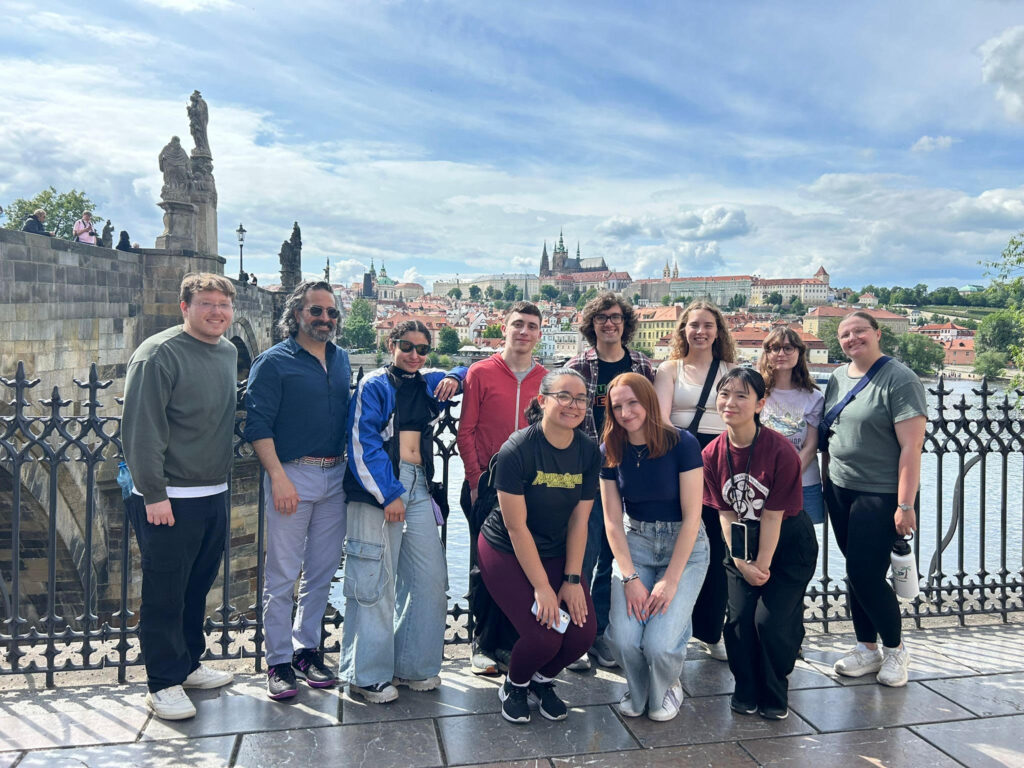
Charles Bridge and Prague Castle (Credit: Shiori Kono)
Review our Itinerary
Monday, May 26
Arrival and Check-in
Welcome Dinner
Tuesday, May 27
CET (host institution) Orientation
Academic Orientation with Dr. Jacob Ari Labendz
Prague Walking Tour
Wednesday, May 28
Labendz Lecture: Jewish History in Bohemia and Moravia
Guided Jewish Quarter Tour
Discussion with a representative of the Czech Union of Jewish Youth
Thursday, May 29
Labendz Lecture: The Holocaust in Bohemia and Moravia
Excursion: Theresienstadt / Terezín (WWII Jewish Ghetto)
Friday, May 30
Labendz Lecture: Romani History and the Samudaripen
Excursion: Lety (WWII Concentration Camp for Roma)
Dr. Salim Murad: History of Roma and Integration
Guest Lecture: Hip Hop Interventions with Romani Youth
Saturday, May 31
Free Day (Travel Permitted)
Sunday, June 1
Labendz Lecture: Czechoslovak Communism for Jews and Roma
Soňa Spěváková (Organization for Immigrant Aid), “Impact of the Ukraine War and the Lives of Ukrainian Refugees in the Czech Republic”
Museum of Communism
State Opera: Platée by Jean-Philippe Rameau, 1745
Monday, June 2
Labendz Lecture: Kolín’s Jewish History and Memory
Excursion: Kolín (forty miles from Prague) / Welcome by the Mayor
Tuesday, June 3
Hosted visit at Romea, Romani Advocacy Organization
Hosted visit at the Society for Queer Memory
Wednesday, June 4
Labendz: Concluding Discussion
Free afternoon to explore and pack
Farewell Dinner at Brambory (Potatoes)
Thursday, June 5
Transport to airport and Departure
Photo Album & Student Journals
Day 1: Arrival
“In the weeks leading up to this trip, I knew I was embarking on a unique and incredibly meaningful experience that would expand my world-view and knowledge of the Holocaust and human rights issues… So far, I have only ever received an American educational perspective on the Holocaust and human rights issues. Therefore, I can see if there are ways the Czech Republic explains the history of the Holocaust and human rights that America could adopt and vice versa.” – Jessica Olshefski
“Flying across the Atlantic Ocean earlier today was the longest flight I have ever been on by a wide margin, and also the flight on which I had placed the heaviest burden of expectation. In the months leading up to this day, I have obsessed about what the journey to Prague could create within my life, and what lessons, both historically and personally, could be unearthed… Perhaps on an even more subconscious level, I began to expect this trip to guide me towards increased clarity and confidence in regards to how I integrate my own passions, academic studies, and personal interests.” – Chris Flug
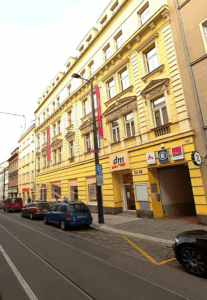
Apartment Living (Google Maps)
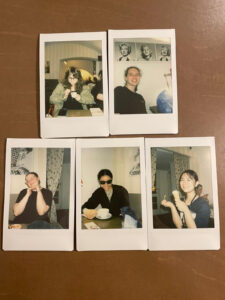
Breakfast cafe near home (Shiori Kono)
“When we finally arrived at the apartment, I was amazed at its size. You walk in and you’re greeted with an open space, where you can look out the windows. The kitchen features a dining table, and there are numerous bedrooms. The fact that we even had a whole room dedicated to the living room was amazing to me. When I finally got to my room, it was huge. It was bigger than any of them post-storms, and I settled in nicely, but I didn’t want to unpack too much because I knew it would be harder for me to pack it up again.” – Catherine Bardzell
Our accommodations were just a quick tram-ride away from the city center. Students loved the ease of the tram network, which offers views of the entire city and insight into daily Czech culture.
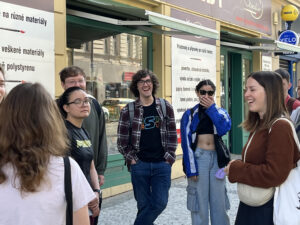
Waiting for our first tram!
Day 2: Orientation and Prague Tour
We enjoyed an expert-led tour of Prague, following our orientation meetings.
“In simple terms, Prague is gorgeous. The architecture and landscapes that you can see all over the city are beyond impressive. The castle is obviously a stand out, but I really liked the view from the park we visited, Kampa. John Lennon’s wall was a cool little spot as well. I would have never thought that something like that would be a somewhat relevant tourist attraction in such a city, but alas, the legend of John Lennon reigns on in the Czech Republic… Since we got to Prague, I can’t help but feel lucky for the opportunity I have to study here. And because I am so lucky, I want to take it seriously.” – Alex Samieske
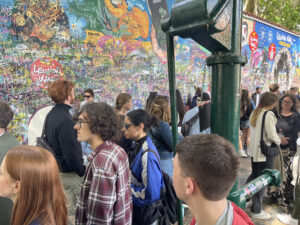
Lennon’s Wall
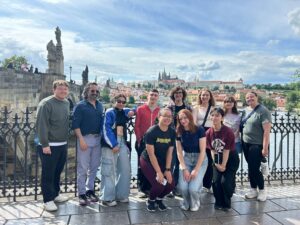
Ramapo Students with Prague Castle and Charles Bridge
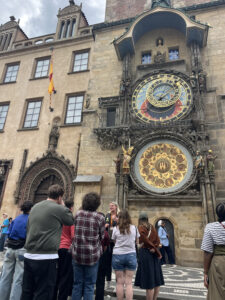
Prague’s Astronomical Clock
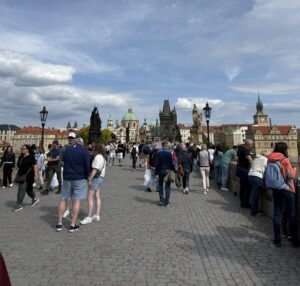
Crossing Charles Bridge (Jamie Metz)
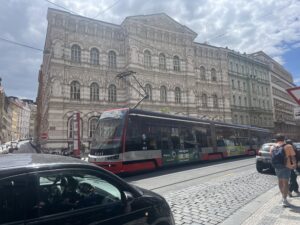
Tram stop for our classes (Rondocubism!) (LeighAnn Sevastian)
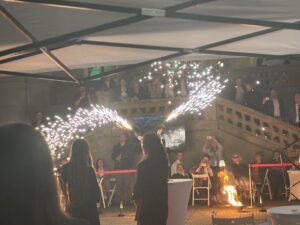
Fire-dancing, Letna Beer Garden (Noah Feldman)
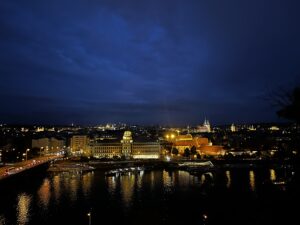
View from Letna Beer Garden (Chris Flug)
Day 3: Jewish Prague: Past and Present
Welcomed into the famous “Kafka Hall” of the Jewish Town Hall in Prague
(Most tourists cannot gain entry to this site.)
“When we visited the Spanish synagogue, I was able to reflect on Jewish belonging in a new way: in architecture. The out-of-the-ordinary building style seemed to be the opposite of assimilation in integration. I thought about the need and desire to belong as opposed to the need and desire to stand out and retain culture. The Spanish synagogue’s style reflected both sides of this.” – LeighAnn Sevastian
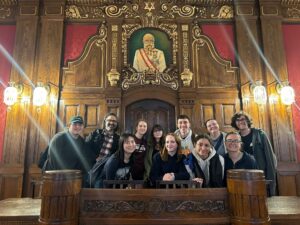
Kafka Room in the Jewish Town Hall (not open to tourists)
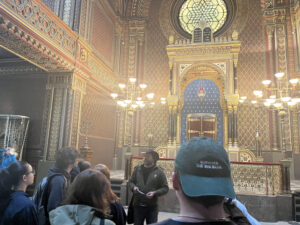
Guided tour of the Jewish Museum: Spanish Synagogue
“My favorite building was the Spanish Synagogue. Unlike the Old-New Synagogue, its interior was richly decorated and stunning. I could not stop looking at the ceiling, where two Stars of David stood prominently in front of the altar. One resembled stained glass, with each point of the star painted in pink. The other was made of metal bars ending in spherical shapes, each sphere containing smaller star patterns.” – Shiori Kono
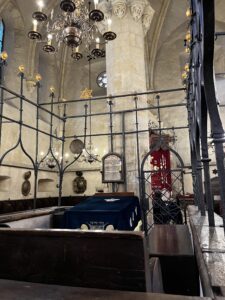
13th century Old New Synagogue (Chris Flug)
“Lastly, our meeting with Elias highlighted how fluid and constantly changing the sense of belonging is. During his presentation, Elias noted the involvement of the Czech Union of Jewish Youth with the European Union of Jewish Students, as well as the significance of the Moishe House. This portion of the meeting truly emphasized how belonging among the Jewish community in the Czech Republic has evolved into a global scale. Of course they still face challenges of belonging in a national setting, but now a new form of belonging poses questions of how the Czech Jews will see themselves in a more globalized society. This also shows how belonging is not a stagnant thing, nor is it one dimensional. It changes over time and adapts to different cultural and political climates. At the same time, there are different levels to belonging as people’s perceptions of themselves and their presence in the world change.” – Jessica Olshefski
Day 4: Theresienstadt/Terezín—The Holocaust
Guided in Theresienstadt/Terezín by scholar and translator Jíři Blažek
Between 1941 and 1945, the Nazis and their Czech collaborators imprisoned over 140,000 Jews in the Theresienstadt Ghetto, primarily from the territory of contemporary Czech Republic. Some 33,000 prisoners died there from executions, torture, starvation, and illness. The Nazis deported 90,000 inmates to camps and ghettoes in the east, principally Auschwitz.
“Throughout our time in the Ghetto, I kept thinking to myself that the ground I was walking on was once walked on by people who had no freedom, no liberty, no food, and were full of fear. I had learned that these were the feelings they had, but I did not fully understand until I was walking around Terezín. I cannot fully put how I felt into words, the best way to describe it is by saying I felt weighed down. However, I felt almost relieved when we visited the small synagogue that had been hidden away because I knew that it was a place of worship and a place where this Jewish community was able to go and be close to those who share beliefs and are experiencing the same conditions.” – Larissa Beattie
“One of the strangest feelings I felt during my trip was walking through one of the beautiful parks in Terezin knowing that less than a century ago innocent people were being murdered for simply being Jewish on that very land. This got me to start thinking about what it must be like to live every day on this land that was once an evil place.” – Noah Feldman
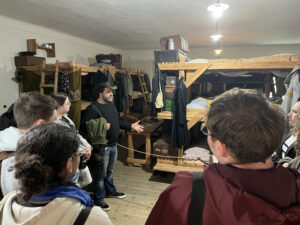
Model of barracks that housed Jewish prisoners in Terezín
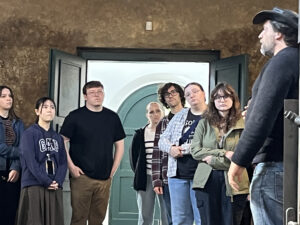
Paying homage at the crematorium in Terezín
“Once we entered Terezin, I realized that all of the mental preparation I went through prior to today could not have helped with the shock of learning that Terezin was used for propaganda. I knew I would be entering a location where atrocities took place, but finding out that people were actually convinced by the lies told about this concentration camp made me feel such a deep sense of disbelief, anger, and sadness.” – Jessica Olshefski
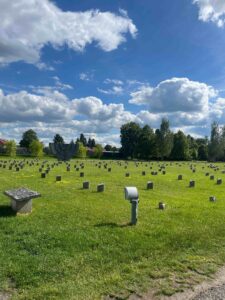
Terezín Jewish Cemetery (Alex Samieske)
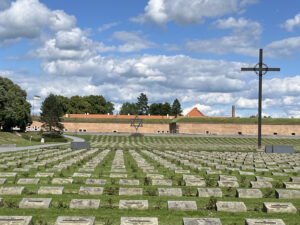
Postwar cemetery in Terezín
“Today, we had a lecture about the persecution of Jewish people during World War II. It was my first time hearing that even people who identified as Christians were discriminated against and sent to concentration camps during the Holocaust simply because they had Jewish ancestors. It was eye-opening to learn how the Nazi regime and much of the public blamed Jews for the economic depression after Germany’s unconditional surrender after World War I.” – Shiori Kono
“Standing on the ground where events of the Holocaust were perpetrated, specifically in the crematorium outside Terezín, led me to reflect on the terrifying consequences of premature exposure to fictional narratives related to the Holocaust. Before we are properly informed, works of literature and visual media continuously reinforce that even the most macabre depths of human suffering will always be counterbalanced by the redemptive actions of a protagonist, within convenient and digestible periods of time.” – Chris Flug
Day 5: Lety — Romani History, Persecution, and Contemporary Life
The newly opened Lety Memorial
Lety u Písku served as a concentration and transit camp for Bohemian Roma in 1942 and 1943. Czech administrators imprisoned more than 1,294 Roma in the camp, housed in overcrowded bunks. The administrators enriched themselves by diverting funds allocated for food, leading to major health crises in the camp. Scholars recorded 335 deaths among the prisoners. The Nazis murdered many more at Auschwitz.
The Czechoslovak government failed to erect a memorial at the site. Adding insult to injury in 1974, it built a large pig farm on the grounds of the former death camp. Only after the passing of a full fifty years—despite protests—did the Czech government remove the sties. A collection of Romani activists and scholars led the construction of the new memorial.
“There is certainly a lot more that needs to be done in terms of honoring and respecting Romani history, but I believe Lety can play a part in that journey. It was so clear that an enormous amount of care went into the construction of the museum and memorialization of the camp. Everyone there genuinely cared deeply about Lety and educating the public about its history. Additionally, the way the various areas of the site combined with the video exhibition explaining Lety’s history all provided a holistic understanding of Romani persecution during the Holocaust. I was especially moved by the audio recordings that were played along the path we took while outside. By listening to peoples’ stories from being at Lety while also looking at the site, I was able to deeply reflect on the history of Lety and its historical significance.” – Jessica Olshefski
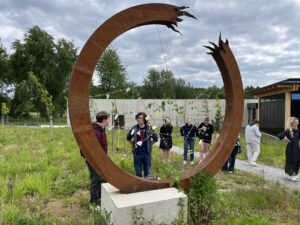
Lety Concentration Camp
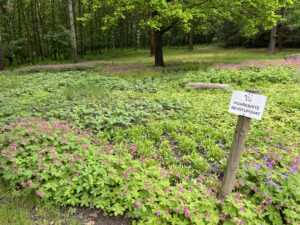
Mass graves at Lety
“Today was the most emotionally heavy because we were standing on the ground of literal mass murders of people who did nothing wrong and were killed solely because of their genetic background. The commemoration site and building were beautifully done. The walkway around where the camp sat and the silver bar of each victim’s name was so thought out, and it is an amazing way to remember this genocide and its horrors. In addition, I thought the extended walkways off of the main circle and educational center were done well and serve the purpose of educating visitors and remembering those who were lost… Lety was beautifully haunting. The land where the camp sat is open and full of wild grass and flowers. However, knowing the history of the land makes it haunting because it was once a place of destruction, horror, and suffering, and you can feel a heavy weight on your shoulders as you walk through the pathways. The winning of this land and the construction of this memorial were significant because they represented a victory. The memorial acts as a bridge between those who suffered and those who came after, offering a space to mourn and honor those who had been lost. The beauty of the land now contrasts with its violent history, which urges visitors to carry the lessons learned there and the responsibility to never forget it.” – Larissa Beattie
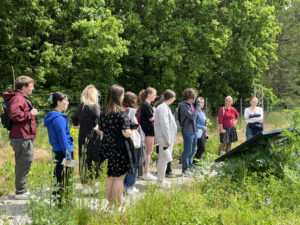
Lety
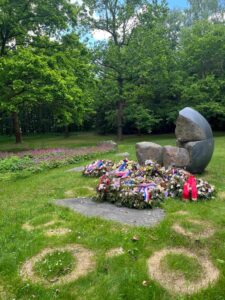
Older memorial (Alex Samieske)
“The flowers also act as a foil to the pig farm that previously existed on the land of the Lety Roma Holocaust Memorial. The pig farm, like the path of the memorial, represents death and ugliness. The pigs are killed over the bodies of the Roma people who died during the Holocaust. While also considering the ugliness of the pig farm, the pig farm demoralizes the memory of the harassed Roma people of the Holocaust. Many people were terribly upset about this and fought for the pig farm to be taken down and the memorial to be built. Interestingly, one of the ways these activists attempted to redeem these forgotten Romani’s was by attaching flowers to the fences of the pig farm. The use of flowers to call out the pig farm and decorate the memorial demonstrates how flowers use their beauty as acts of rebellion against death.” – Noah Feldman
“I am grateful that I had the opportunity to visit Lety and learn about this part of history. I hope to share what I experienced today with others, so that the memory of the Romani victims is preserved and their suffering is not forgotten.” – Shiori Kono
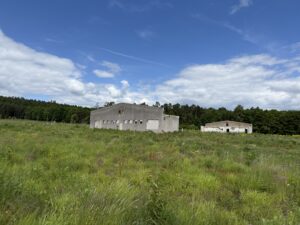
Preserved remains of the pig farm at Lety (Jamie Metz)
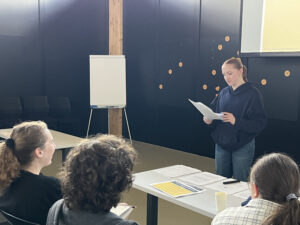
Larissa reads a poem
”Todays material about the genocide of the Roma people, in conjuncture with the visit to the concentration camp at Lety, expanding my understanding of how the atrocities of the Holocaust were far more complex than the most commonly told story of German facism and Jewish suffering… Later in the day, while listening to the passionate guest lecture by Salim Murad, I realized just how easy it is for the suffering of marginalized groups to be left behind in the popular telling of history. Most educational institutions only focus on the mass murder of the Jews during the Holocaust, while Mr. Murad and his colleagues are dedicating their lives to informing the public about the Roma genocide, and the continuing estrangement of Roma in the Czech Republic.” – Chris Flug
“When we arrived, my first reflection on the commemoration site itself was how remote it was. We were told that there is still no accessible, scheduled proper public transport to bring the general public to Lety. Therefore, students and others who could be educated and enriched by visiting the site most likely do not get the opportunity to go. I considered how this mirrored the isolation of an ethnic group subject to massacres… I recall seeing and also feeling the frustration of the survivors in the footage about the pig farm that was built on Lety and the way that, for a time, the government actually expanded it. I thought this part of the commemoration site was therefore enduring and relevant to its purpose.” – LeighAnn Sevastian
Day 6: Free Day
On their free day (and again on the last day), students explored new regions of the Czech Republic and parts of the city they had missed.
“What surprised me the most was how small moments or wrong turns became opportunities to learn something new. A perfect example is when Carolyn and I were trying to find a coffee shop, took a left turn, and ended up walking through a Vietnamese market. I knew that the Vietnamese population in Prague was high, but it was so nice to see how they have integrated into the community and still are connected with their traditional food, clothing, and arts. It is always interesting to see how cultural influences from different communities blend into the everyday life of large cities like this.” – Larissa Beattie
“My free day was spent in Brno. It was really cool to take a train through the countryside of the Czech Republic, and though the city was not as nice as Prague, I was pleasantly surprised with it. The purpose of my visit was to see the Museum of Romani Culture, which was located just outside the center of the city.” – Alex Samieske
“In the context of today’s trip to Brno, I am grateful that the efficiency of the Czech train network speedily brought me through many sights of awe-inspiring natural beauty promptly enough for me to bring my most wakeful state of the day to the streets of the city.” – Chris Flug
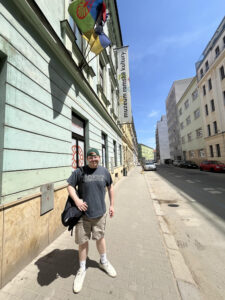
Museum of Romani Culture, Brno (Alex Samieske)
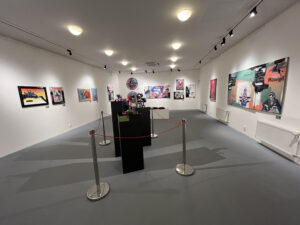
Art at the Romani Museum (Alex Samieske)
“On my free day, I went to the Prague Zoo. I had planned to go there since I first saw the scheduled free day months ago, so nothing would stop me. I love bears, especially polar bears, and the Prague Zoo is known for keeping them… We saw Japanese giant salamanders, an Amur tiger, an elephant shrew, an Indian gharial, and an emu with chicks. My second favorite habitat was for the Indian elephants. Viewers were allowed to get very close to them and I was completely in awe. The biggest one had green grass and leaves on its back as if it were a mountain.” – LeighAnn Sevastian
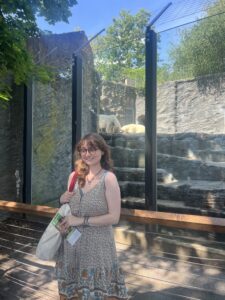
Visiting the polar bears in the Zoo (LeighAnn Sevastian)
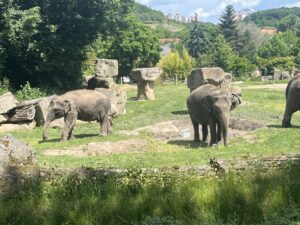
Elephants in the Zoo with communist-era housing blocks in the distance (LeighAnn Sevastian)
“On my day off, I went on a three-pronged tour of the Bohemian-Swiss International Park. The park straddles the German border, resulting in one prong of the tour being in Germany. The first prong consisted of a hike to the Pravcicka Gate stone arch… The next part of the tour took us to the Kamenice Gorge. The tour brought me down the steep, wet steps of the ravine. We continued down the path and eventually made it to a dock where gondolas would take groups of people up and down a section of the river Kamenice at the bottom of the ravine. The boat ride was relaxing, and the German speaking rower would crack jokes and point out silly looking rocks along the cliffside that my tour guide would translate.” – Noah Feldman
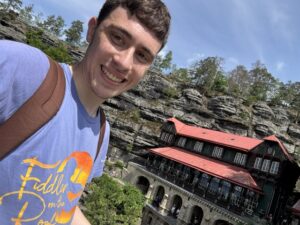
Hotel in “Czech Switzerland” (Noah Fedlman)
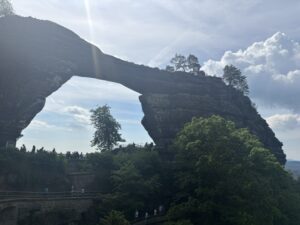
Czech Switzerland (Noah Feldman)
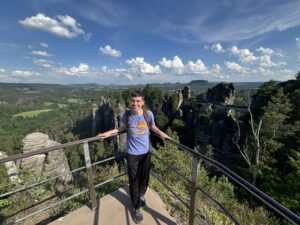
Czech Switzerland (Noah Feldman)
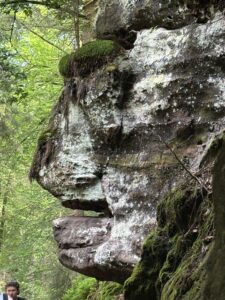
Czech Switzerland (Noah Feldman)
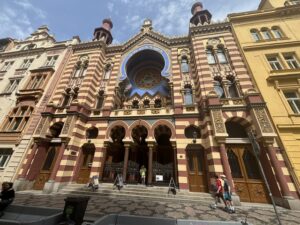
Jubilee (Jerusalem) Synagogue (Noah Feldman)
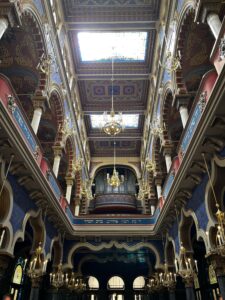
Jubilee interior (Chris Flug)
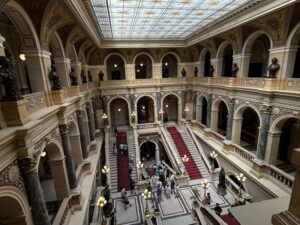
National Museum (Noah Feldman)
Day 7: Communism, Contemporary Refugee Issues, and the Opera
Platée (1745) by Jean-Philippe Rameau, State Opera
The day began with a presentation from an immigrant rights organization in the Czech Republic, featuring reflections on the processes of migration and the specific issues facing Ukrainian refugees in Czechia today. The Museum of Communism introduced students to the material, political, and social challenges of life in communist Czechoslovakia. Dr. Labendz spoke in the morning about the lives of Jews and Roma during communism.
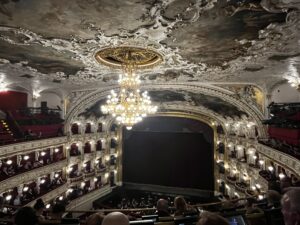
National Opera (Credit: Chris Flug)
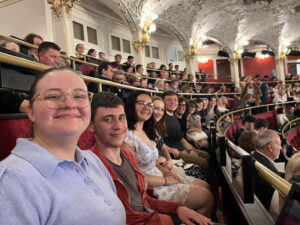
The State Theater
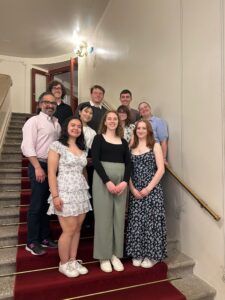
Putt’n on the ritz
“We learned from the presentation that Soňa’s organization was the first NGO to meet and help Ukrainian refugees at the Main Station in Prague. In terms of the legacy of the Holocaust and the Cold War, I contemplated delayed responses to minority groups’ suffering during both events. Perhaps communication being so much more quick and effective than it was eighty years ago plays a role in fast and empathetic responses to suffering.” – LeighAnn Sevastian
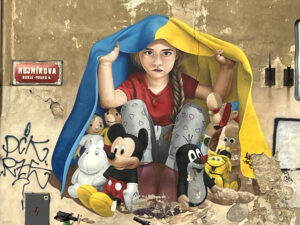
Pro-Ukraine Graffiti
“… I did not speak English when I first moved to the United States, and I had to rely on gestures to communicate. Reflecting on that time, I remember feeling very isolated and anxious in American society, and I imagine many refugees in the Czech Republic must be experiencing similar emotions. Although I am still learning English, it was relatively easier for me to acquire the language compared to my parents, likely because I was younger and more adaptable. Therefore, I strongly connected with what Ms. Špěváková said about older refugees needing more support. They often struggle with language barriers, which can make it difficult to find employment and meet their basic needs.” – Shiori Kono
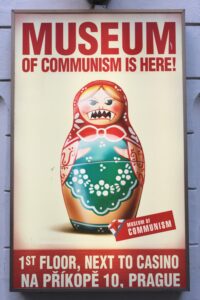
Old MoC poster (WikiCommons)
“I especially liked all the artifacts available [at the Museum of Communism], which showcased daily life and the realities of the people. I believe this is much better than any textbook because the Czech Republic was once a communist country, and it is pretty interesting to see how the people reacted to this. – Cathrine Bardzell
Day 8: Kolín Jewish History and Memory
We visited Kolín because the Center for Holocaust and Genocide Studies cares for and displays a 250 year-old Torah scroll from that city. It survived the Holocaust in Prague’s Central Jewish Museum. The scroll is on permanent loan from the Memorial Scrolls Trust.
Since the 1980s, Kolín has demonstrated a commitment to its Jewish past, empowered by connections it has forged with communities around the world which, like CHGS, serves as a custodian for a Kolín Torah scroll. The mayor greeted us personally, welcoming us into his office and City Hall’s incredible ceremonial hall.
“One thing that struck me particularly regarding our visit to Kolin was how much they advertised the hidden synagogue. It almost felt like the synagogue was the city’s ‘number one attraction’. When we were meeting with the mayor, I was very curious as to how a city with such a miniscule jewish population would be adamant on people visiting their synagogue. I asked the mayor if young students in the city learned about Jewish history in Kolin– if you advertise Jewish history as a reason to visit Kolin, I would have expected everyone in the city to have learned about it. However, when I asked this question the mayor replied with ‘We try’.” – Alex Samieske
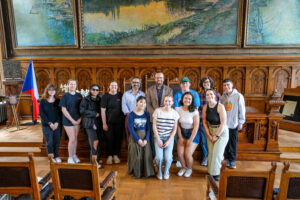
Ramapo with the Mayor of Kolín
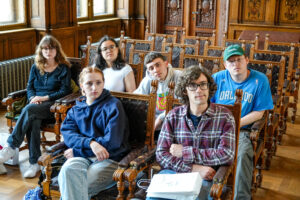
The mayor was interesting!
“I was amazed when we visited the mayor, as I had no idea he was so invested in meeting us. I saw that it was part of our itinerary, but it was even more impressive to see them so passionate about sharing their history and lives with us. I especially loved the place he took us after his office, with the huge paintings on the wall of Kolin.” – Catherine Bardzell
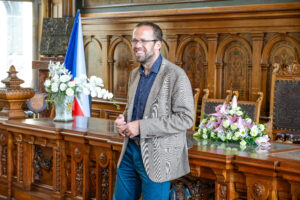
Michael Kašpar, Mayor of Kolín
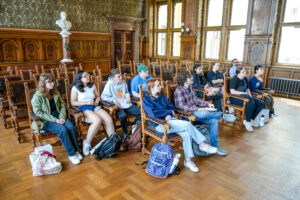
Listening to Mayor Kašpar
“In Czech Republic, especially Kolín, Czech Jews and their history are treated as part of Czechia’s overall history, at least more than most other countries. This is evident by the number of Jewish museums, stories, and historical figures that are prized in places like Prague and Kolín.” – Noah Feldman
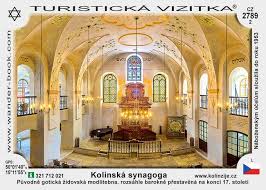
Postcard: Kolín Synagogue Interior
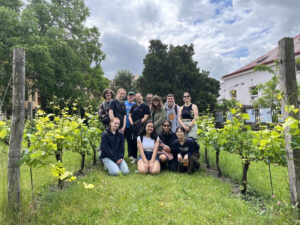
Vineyard of the Kolín Synagogue
Dr. Labendz insisted upon finding Kolín’s New Jewish Cemetery, if only for a chance to peer over the walls. The students enjoyed playing “Indiana Jones.”
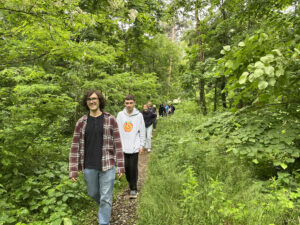
Accompanying Dr. Labendz to Kolín’s Old Cemeter for research
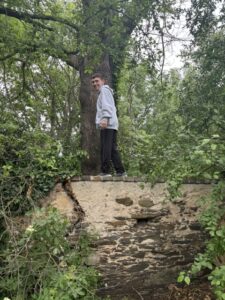
Peeping Kolín’s New Jewish Cemetery (Noah Feldman)
“When we were in Kolin, the guide referred to the synagogue as ‘our synagogue.’ This resonated with me because it truly seemed that the people in Kolin view Jewish history as a significant part of the town’s overall history. Even if there is barely a Jewish population left in Kolin, there is a greater sense of pride in the Jewish history of the town and an understanding of its importance.” – Jessica Olshefski
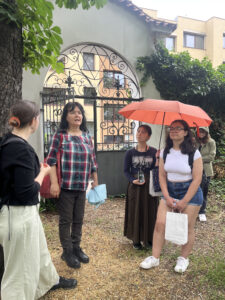
Kolin’s Old Jewish Cemetery
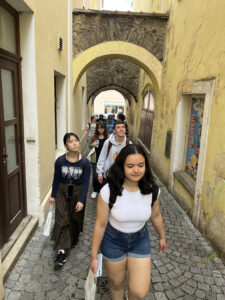
Kolín is pretty
”Remembrance can be done in any way, shape, or form, and Kolin embraced ways of remembrance that are more subtle and just as respectful to the Jewish community. Kolín offers a more intimate view of how communities can remember their Jewish past.” – Larissa Beattie
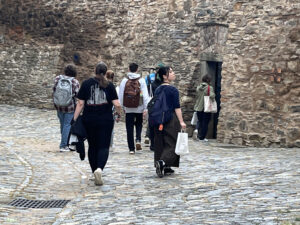
Medieval Kolín
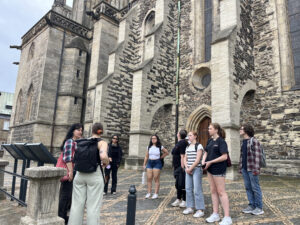
Cathedral in Kolín
Day 9: Romea (Romani Rights) and Society for Queer Memory
To properly study a genocide, one must focus not only on the years of murder, but on the experiences and living conditions of the targeted communities before, during, and after the crime. We must do so, first and foremost, to avoid objectifying the communities whom we seek to study and commemorate.
Studying victimized communities in comparative perspective also helps us to learn more about the causes, conditions, and repercussions of genocide. Just as we met with a representative of the Czech Union of Jewish Youth, so too did we learn from NGOs that advocate for Roma and members of the LGBTQ+ community. Whereas our friend at the Jewish community spoke about the general wellbeing and acceptance of Jews in Prague, the organizations, Romea and the Society for Queer Memory, introduced us to the ongoing challenges faced by these communities and their self-advocacy.
“I wanted to stay at the Center for Queer Memory all day. I was not knowledgeable at all about the queer history of the Czech Republic at all and I thought our visit was extremely enriching. We learned that information about HIV and AIDs was not provided in almost any other media besides the queer magazine runs that we looked at (such as Lambda). To me it seemed to reflect the crisis in America during the same time period, and that generation being forced to form their own survival plans. I deeply loved looking at the small art pieces and poems in the magazine issues and I would kill to be able to read just one of them translated in English. I would like to be able to feel authors’ emotional states during a time when publication may have saved them.” – LeighAnn Sevastian
“The queer community has made a lot of progress in hosting pride events and visibility events! The archive we visited today revealed this, and although there was plenty for him to show us, a lot of it was hidden away for a long time.” – Larissa Beattie
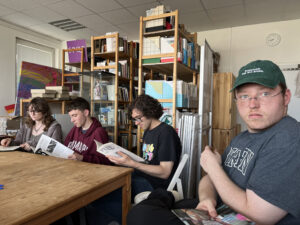
Library of the Society for Queer Memory
“Romea has started many projects to combat the misinformation in the media and present a new narrative of Roma. One of these projects is the Baruvas which are summer camps that educate Romani young people about their culture, history, and language. The goal of these camps is to make young people proud of their Romani heritage rather than trying to hide it. They have also started a scholarship program for Roma students so that they can afford to go onto higher education. Romea has also filmed interviews with the older generation of Roma to talk about Romani history from firsthand accounts so that this information can be recorded, preserved, and spread among the population… It is unfortunate that efforts must be taken in the media just to show that Roma are normal, everyday citizens because in a democracy they should not have to prove themselves in this way. If one is living in a democratic country they should be automatically granted the same rights as every other citizen but persecution and discrimination against Roma has existed for so long that it has become deeply rooted in the minds of the Czech people and in the institutions that should be serving them.” – Jamie Metz
Romea featured our students on their InstaGram Reels.
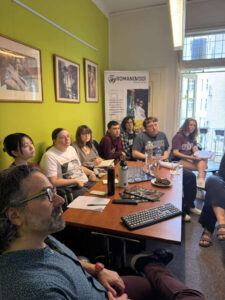
Learning from Romea
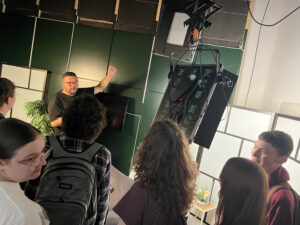
Touring Romea’s studio
“To address these issues, Romea has been working to build a supportive community where Romani people can express their views and preserve their culture. The organization also provides scholarships to help Romani youth access higher education, which can lead to better economic opportunities and improved social status. Mr. Balog shared his own personal experience with identity. He explained that he struggled to accept his identity as Roma because of the widespread stigma. It was not until his grandmother shared her story of being sterilized that he began to take pride in his heritage and started learning more about his culture.” – Shiori Kono
“Today was a really interesting day. It started with a visit to Romea, which was a NGO dedicated to supporting Roma communities around the Czech Republic. In my opinion, the presentation given to us here was one of the most important ones that we had as a class. To speak with members of the Roma community provided us with insight that we previously did not have. We had of course learned about the Romani plight in the Czech Republic, but to hear about it from a member of the community themselves amplified the importance of issues surrounding Roma people in the country.” – Alex Samieske
Title 10: Farewell to All That
“This trip was unlike any other academic experience I have had and I am so grateful to have had the privilege of participating in this. One of the main lessons I took away from this experience was that it is necessary to be uncomfortable in order to learn. Looking back on my public school education, I realize now that a lot of what I have been taught about the Holocaust and human rights issues has been watered down significantly for the sake of not making people feel uncomfortable. This comes at the cost of accurate knowledge and understanding though. I grew up having a general idea of the atrocities of the Holocaust and the injustices many marginalized groups experience, but it always seemed so far away and irrelevant because I never received a thoroughly honest explanation.” – Jessica Olshefski
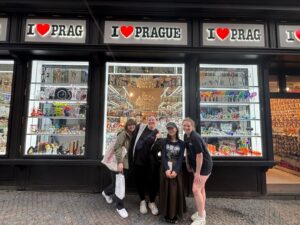
Stopping for souvenirs (Jamie Olshefski)
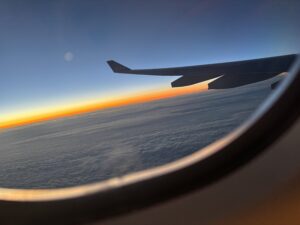
Flying home (Noah Feldman)
“Visiting the sites of mass atrocities, speaking with public officials and employees of NGOs, and absorbing vast amounts of information about the history of minority groups in the Czech Republic reminded me that learning and listening are far more important skills than writing cover letters.” – Chris Flug
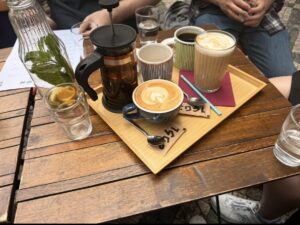
Starting the day right (Larissa Beattie)
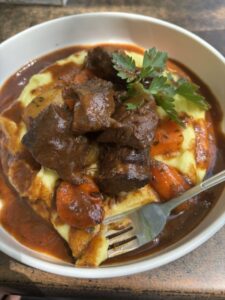
Guláš! (Chris Flug)
“I cannot believe this experience is already over. The last ten days have been something I never expected I would get the opportunity to have. Being able to study abroad has been one of my top bucket-list items for as long as I can remember, and being able to do it in a country with such a rich account of recent history while studying a topic that has always piqued my interest is something special to me… I would say the most important lesson I learned was the importance of acknowledging other cultures. Being able to understand the history behind all communities, especially ones that have historically been discriminated against, is crucial in our modern world. As a person who wants to eventually become an educator, I find it very important to learn about as many cultures as possible to be able to build a strong connection with any future students and their families.” – Larissa Beattie
We would like to thank our local program coordinator, CET Academic Programs, for managing logistics and providing round-the-clock services to keep our students safe and well oriented.
The Holocaust and Human Rights in Prague was planned in coordination with the Dr. Erin Augis and the Honors Program. Students earned two credits for participating. Honors students enjoyed the option of using the program to fulfill a portion of their research and writing requirements. The CHGS would additionally like to thank Paul Current and Kate Lamanna from the Roukema Center for International Education for their support.
The CHGS provided a $1,400 scholarship to each participant thanks to generous donations from: Beth Haverim Shir Shalom in Mahwah, NJ, Congregation Rodeph Sholom in Bridgeport, CT, Rosalyn Ross, and anonymous. The S. Rubenstein Family Foundation offered a $3,000 scholarship to one of our participants.
Copyright ©2025 Ramapo College Of New Jersey. Statements And Policies. Contact Webmaster.

Follow Us!